Movies and TV gave the audience a glimpse into the life and way of life of the ancient samurai.
Through their dedication and self-sacrifice, these noble men led the way of the samurai, mastered their weapons and minds, and preserved their art form.
The samurai were around for almost a millennium in Feudal Japan.
They followed orders with the greatest loyalty to their masters and to each other. In addition, they are remembered for their bravery and inspiration for art.
Samurai

The samurai (侍) were members of a Japanese warrior caste (class). They existed for more than 700 years in feudal Japan.
As a result of the warrior caste coming to power in the 12 th century, the term "samurai" applied to all warriors, including aristocratic warriors. Their class dominated the Japanese government.
They started as guards and protected Japan from invasion. It was their mission to defend territories against rivals, fight enemies identified by the government, and fight enemy tribes and bandits.
Lords of the government hired samurai to serve as private armies for their country. As for where they lived, they had the choice between the barracks, a castle or their private home.
While there were other warrior classes, only samurai served in the imperial court (government) where the emperor performed political affairs and duties.
Bravery on the battlefield was crucial.
As traditions developed, the samurai would ride into battle, proclaiming their ancestry and past deeds, and even challenging some of the enemies to single battle.
During the Edo period (1603 - 1868) developed a standardized status system:
- Gokenin (御 家人) (homemaker) was the lowest rank and vassal (given used by land in return for military service) by a feudal lord.
- Goshi (郷 士) (rustic warrior) could cultivate his land, but could not have two swords of full samurai rank.
- Hatamoto (旗 本) (banner guard) was the highest ranking. It was for those who were waiting to die to protect their master's interests.
The Story of Samurai in Feudal Japan
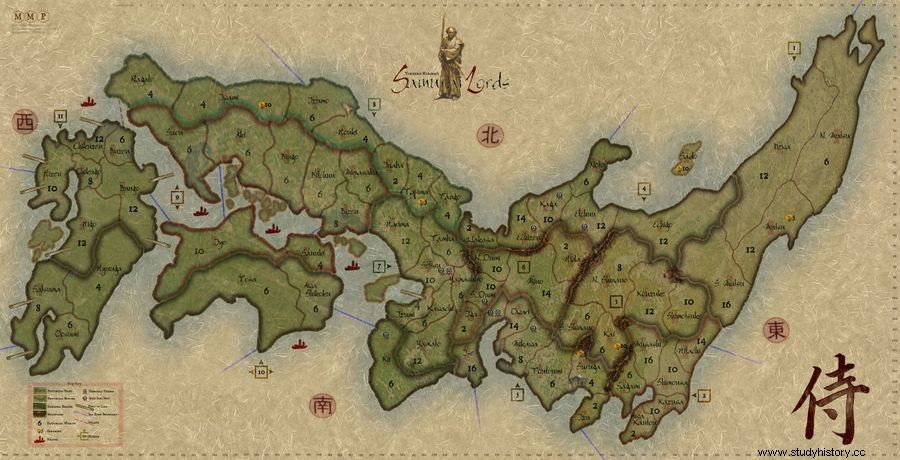
Early Samurai - Heian Period (794 - 1186)
During the Heian period (平安 時代), the samurai were the armed support of wealthy landowners in feudal Japan. Their fortune was measured in smell . And smells was the amount of rice it took to feed a man in a year.
Further into the 12th century, the real political power in Japan gradually moved away from the emperor and his nobles. It went to the clans of the government's largest states.
Thus began the Genpei War (1180 - 1185). The clans of Taira and Minamoto fought against each other for control of the state.
One of the most famous samurai, Minamoto Yoshitsune (源 義 経), led the Minamoto clan to victory.
Rise of the Samurai - The Kamakura Shogunate (1185 - 1333)
Under the Kamakura Shogunate (1185 - 1333), Minamoto established Yoritomo (源 頼 朝), half-brother of Yoshitsune, the center of the government in Kamakura.
The shogunate was a hereditary military dictatorship. The real political power moved to the samurai.
Yoritomo's authority depended on the strength of the samurai, hence the underlined status of the samurai.
No one could call themselves a "samurai" without the permission of Yoritomo.
Zen Buddhism, introduced by China, became a major appeal to the samurai.
The sword became more important.
Ashikaga Shogunate (1336 - 1573)
I 13 th century, the Kamakura Shogunate weakened to defeat two Mongol invasions.
In 1336, the Kamakura Shogunate revolted, led by Ashigaka Takaiyi, during the Muromachi period (室町時代).
With the Onin War (1467 - 1477), shōgun (prime minister) proved ineffective in his duties.
Feudal Japan lacked the strong central authority it needed. The local lords and samurai had to work harder to maintain law and order.
Despite the political unrest, there was significant economic expansion in Japan.
Samurai culture was increasingly influenced by Zen Buddhism.
Ashikaga Shogunate was the golden age of Japanese art.
Tokugawa Shogunate (1603 - 1867)
For 250 years, there was peace and prosperity in feudal Japan under Tokugawa Ieyasu (徳 川 家 康) during the Edo period.
The samurai took order through civilian action instead of military force.
Ieyasu implemented 'ordinances for the military houses'. The samurai should train equally in weapons and "polite" learning in accordance with the principles of Confucianism. This, as a result, darkened Buddhism as the dominant supporter of the samurai.
The samurai were forced to become bureaucrats or take a trade.
In 1588, the right to carry a sword was limited to samurai only, resulting in further separation between the samurai and the peasant-peasantry.
Consequently, the samurai became known as the 'two-sword man'. They wore both long and short swords as a sign of privilege.
Traditionally, the samurai lived on a fixed scholarship from landowners. When the scholarship went down, the samurai at a lower level became frustrated at the inability to improve the situation.
In other words, it was a decline in the material well - being of the samurai.
Meiji Restoration and the End of Feudal Japan
A combination of factors undermined the Tokugawa regime, such as the rise of farmers due to famine and poverty. The last straw was the invasion of Western powers, which aimed to make Japan part of their international trade.
In 1858 a controversial decision was made. A treaty was concluded with the United States. This led to conservative forces, including the samurai, forming a resistance against the Shogunate. They wanted the restoration of power to the emperor.
Meanwhile, two powerful clans, Choshun and Satsuma, combined their efforts and ended the Tokugawa Shogunate (徳 川 時代). In 1868, named after Emperor Meiji, the Meiji era was an 'imperial restoration', hence the Meiji restoration (明治 維新).
In 1871, with the abolition of feudalism, the use of swords was banned
After almost a millennium, the samurai lost their special place in Japan. Their families remained, but without occupation, no position, no privileges, no land and no sword.
Just like feudal Japan, the samurai were no longer.
Bushidō - 'Way of the Warrior'
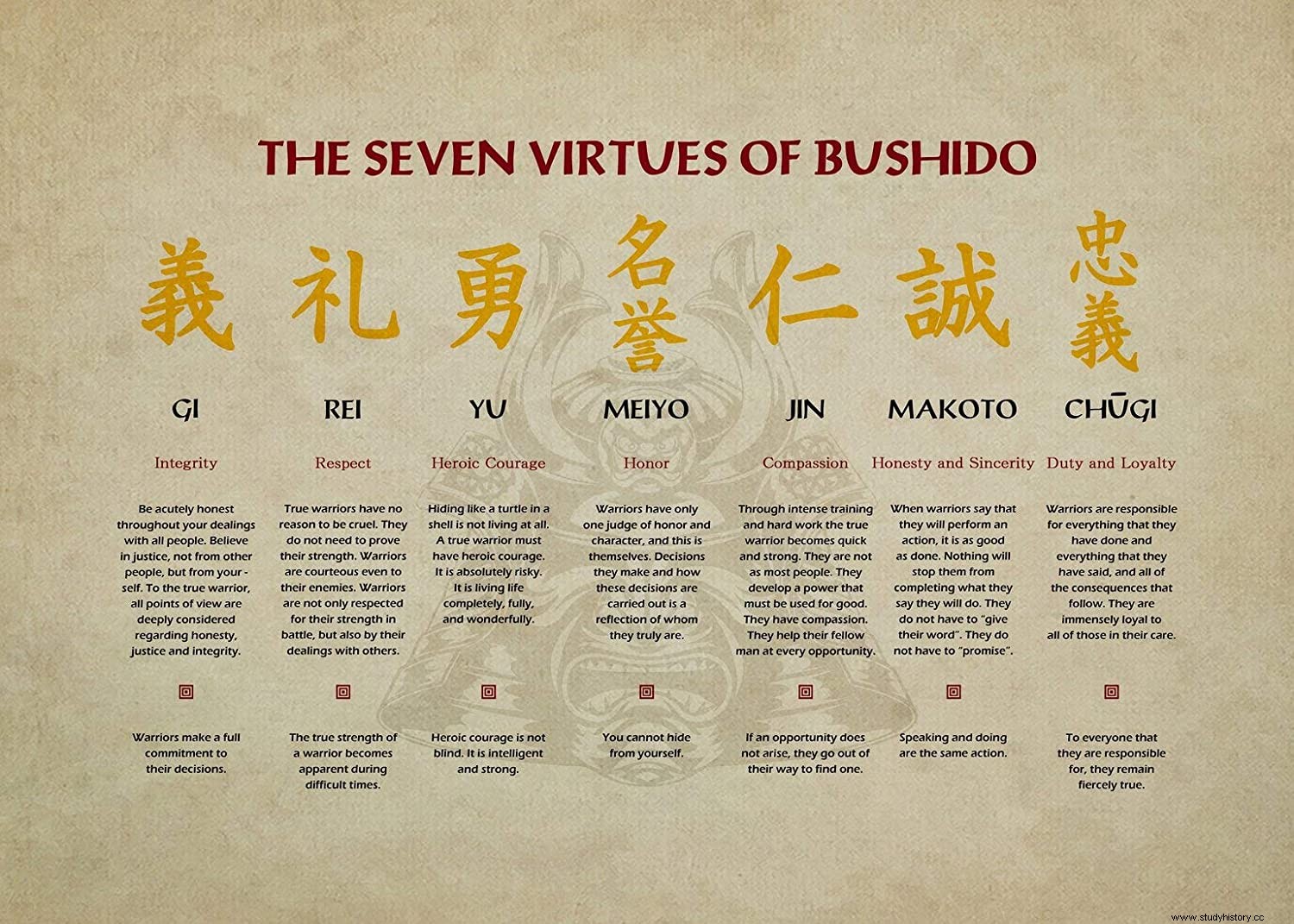
Bushidō (武士道) appeared under Takugawa Shogunate, followed by the samurai and their forerunners in feudal Japan.
It served as a moral code for attitudes, behaviors and lifestyles. It emphasized the honor, courage, skill of martial arts and loyalty to a warrior master.
In the same way, it emphasized military skills and fearlessness in the face of the enemy.
An elaborate list of virtues is given, such as frugality, justice, courage, benevolence, respect, sincerity, honor, loyalty, self-control and care for one's family.
Specific restrictions varied over time and from place to place in Japan.
Bushidō was more of an ethical system than a religious belief system, and varied under Buddhism and Confucianism.
Through Buddhism, they believed that they were excluded from rewards in the afterlife when they practiced fighting and killing in this life.
Training of Samurai in Feudal Japan
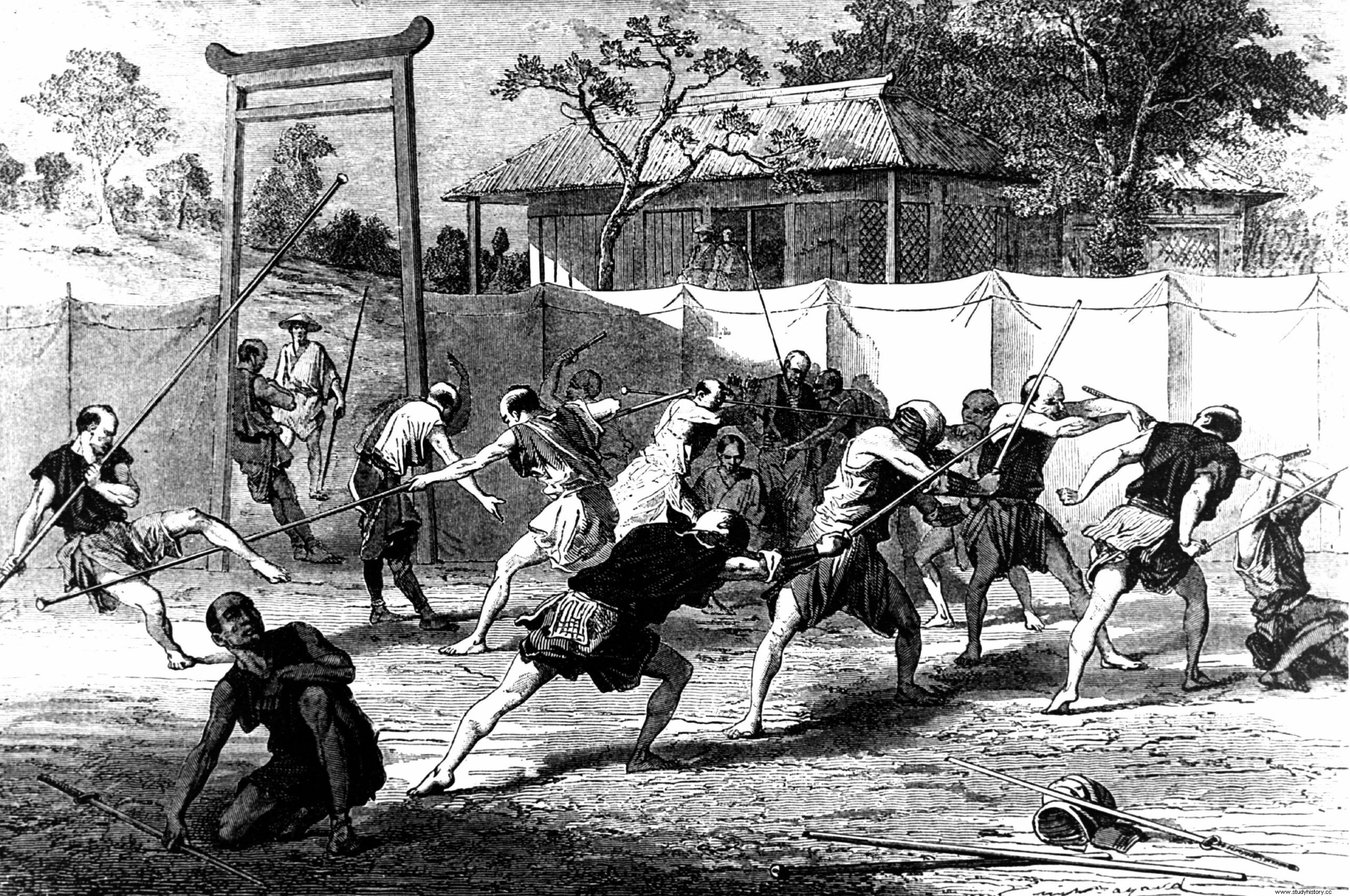
Physical conditioning
The samurai conditioned themselves and proved their physical toughness by fighting with the elements.
For example, they would stand naked in deep snow or sit under an extremely cold waterfall.
They would go without food, water or sleep to strengthen themselves against deprivation.
Heavy drinking used to be a preferred method of building endurance and increasing strength.
Unarmed combat
The samurai practiced many martial arts for situations when armed.
Bujusu, an umbrella term, covers all traditional martial arts, such as Kenjutsu, Sojutsu and Jojutso.
These are some of the martial arts for unarmed combat.
Karate is where physical aspects seek the development of defensive and counter-attacking body movements.
Judo aims to throw, fasten or master the opponent by putting pressure on the arm joints or neck until the opponent gives in.
Akido focuses on harmonizing with your opponent to bring peaceful solutions to situations involving conflict.
Weapons work
During training, their weapons consisted of a sword, bow and spear.
During the feudal period, samurai were encouraged to train in schools opened by fame instructors throughout Japan.
Wooden weapons were when samurai sparred each other.
Swords were against dolls of wood and straw and weapon techniques against slaves and prisoners.
Chinese Studies in Feudal Japan
Chinese culture served as a collection of 'cultural building blocks', selectively introduced and modified in the Japanese tradition.
Remember that this does not mean that Japanese culture is an extended version of Chinese culture.
In addition, Japan's use and interpretations of Chinese elements did not deviate from the original teachings.
Poetry
As a release for samurai expected to maintain a strict order over others, they wrote a lot of Haiku. The samurai were supposed to be cultural students and not just fierce warriors in feudal Japan.
Meditation
Through Zen meditation, the samurai were able to improve the clarity of battle instead of letting fear or anger drive their actions.
It provided an ideal philosophical background for the samurai's own code of conduct. They remained one with the surroundings and the opponents, and made the samurai legendary warriors.
The spiritual path to Zen was the most appealing.
The truth is in the deepest core of one's interior, not their intellect. Then the truth would be within reach of the samurai's consciousness and emotional abilities.
Meditation did not provide much physical training or knowledge of military strategy. It allowed the samurai to open up combat training to their subconscious.
Appearance of Samurai
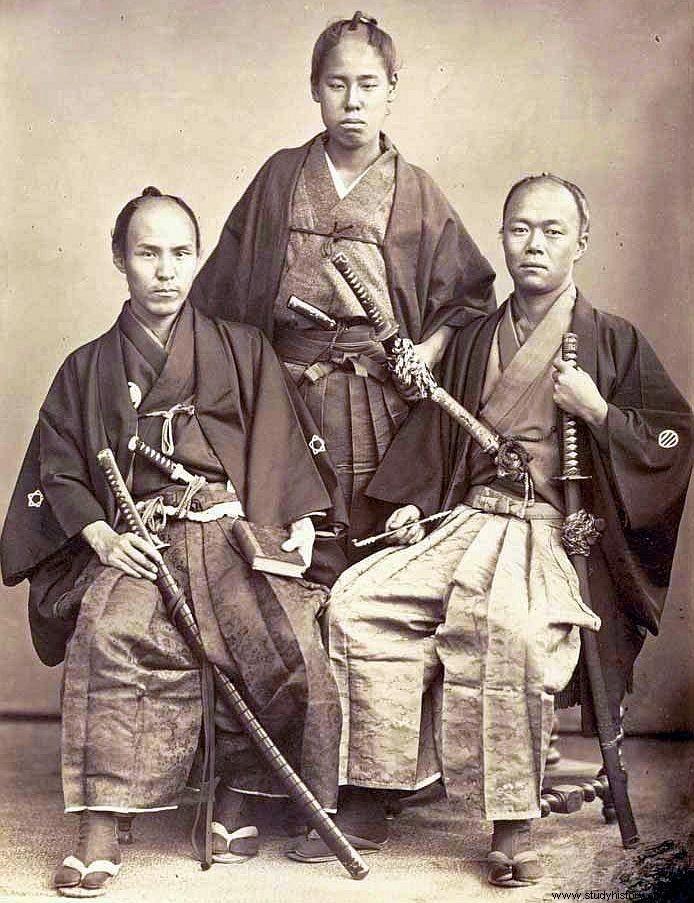
Wardrobe
The dress code of the samurai is especially important as an indication of status.
Eccentric colors and colorful patterns were obscene and conceited, but they dressed flamboyantly.
After the government ceremony, their appearance became more subdued.
Everyday clothes consisted of a kimono on one or two layers and a loincloth underneath. Usually it was made of silk, but the quality depended on income and status.
The obi was a belt tied at the waist. The samurai placed the sword through the obi on the left.
Once indoors, the sword was removed and samurai remained armed with some form of weapon.
When outdoors, a two-piece suit called a 'kamishimo' was worn over the kimono. The top was a sleeveless jacket with exaggerated shoulders. The bottom piece was 'hakama', a pair of wide floating pants.
During their travels, a long-sleeved coat was worn over the kimono.
While in town in his spare time, a samurai wore a basket-shaped hat that hid his face. The intention was to avoid being recognized if he did not obey a rule.
Hair
The samurai were very careful to style their hair in a chonmage , the hair pulled back and up to a top knot.
For battle, they shaved the top of their heads and kept their hair straight at the sides.
Wearing a heavy helmet helps reduce heat. Without a helmet, the side and back hairs are pulled back to a top knot.
Føydal Japanese Samurai armor
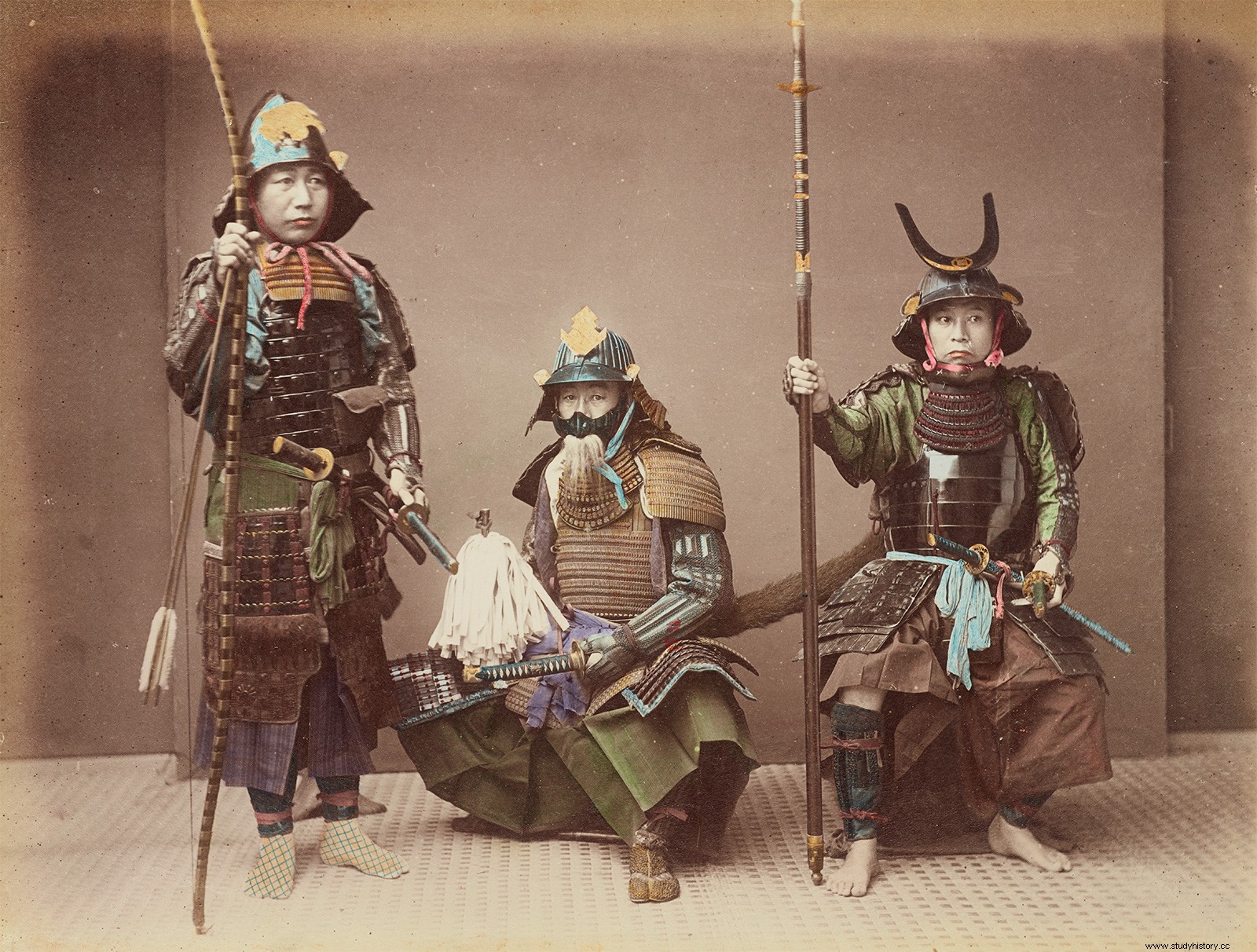
The samurai armor consisted of coated pieces of leather, iron and skills to divert swords and arrows.
A black varnish coated the iron plates. Silk tied the plates together to help with the flexibility of the armor.
A kuzazuri was an armored skirt that shielded the thighs.
Armrest was a combination of protective chain post with fine blue silk.
The Kabuto is a helmet with a bristle mustache. Its design is to lure fear into the enemy.
An armor consisted of 250 years (230 meters) of silk and over 3000 pieces of thick leather.
Weapons of the Samurai
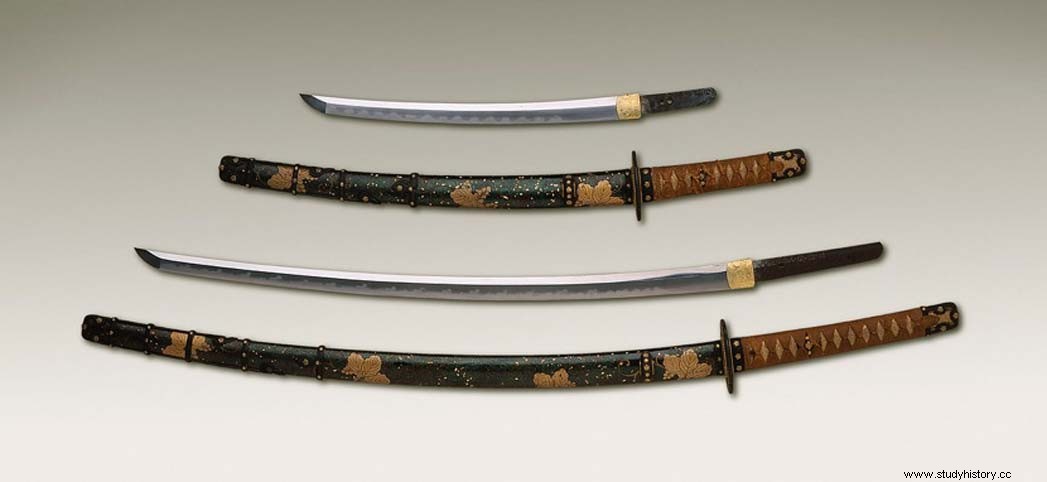
Katana (日本 刀)
The katana was the most prominent and vital weapon and above all one of the deadliest.
As a status symbol, those of the samurai class had the privilege of having such a weapon. It was an extension of the samurai's soul. If one were not of the samurai class and wore a katana, they would face an immediate death.
Polishing a katana was a longer process than forging one. It was very important and revealed the true quality of the black.
The grain and hamon of the steel (the temperate line of the blade) were more visible.
Wakizashi (脇 差)
The blade was shorter than the katana and served as its companion.
Wakizashi was to fight in small places where a katana could not.
Also, it was a spare weapon for beheading a defeated enemy.
So much
An aunt is a single-edged, curved blade.
This weapon was not primarily for war because the blade was too small to go against the spears and swords.
However, designed specifically for soft targets, it proved effective in penetrating armor.
From 794 to 1185, it was just a standard weapon with no artistic qualities, a practical piece created by distress.
Between 1185 and 1333, the weapon was more artistic and of high improved quality.
In 1336, tantō began to be used for combat purposes.
The magazine's artistic appeal slowly diminished, the need for it increased, and therefore mass production increased.
The blade of the tanto became narrower to reduce the use of materials and made it possible to produce more blades.
Samurai and the Feudal Japanese Heritage
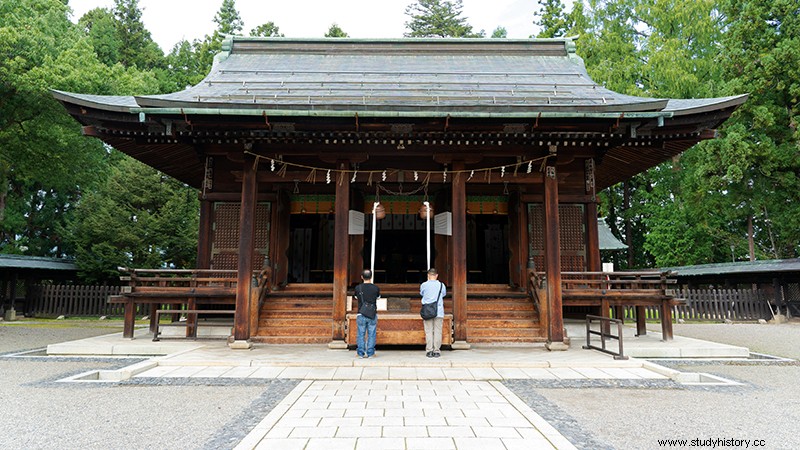
After the fall of the samurai, the people of Japan became nostalgic and continued to praise the heroic warriors.
Samurai literature flourished and romanticized their image.
The role the samurai played in an oppressive feudal system was forgotten.
Their legacy continues through their honor, skill and devotion to art.
Many people still practice martial arts in the same way as the samurai, even to the extent that they follow their original code.
Cultural significance in anthropology
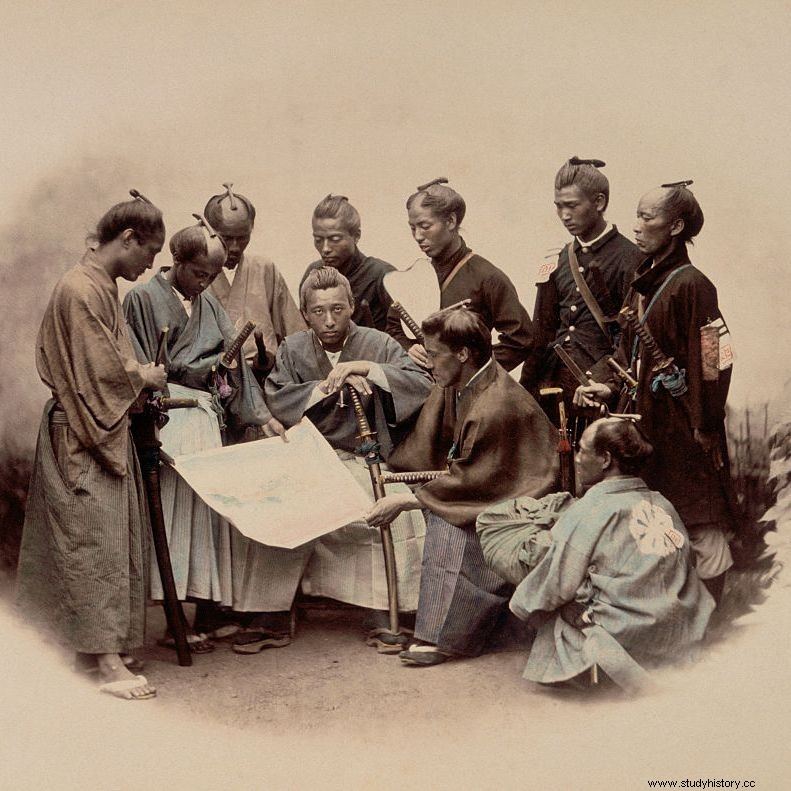
From acts of bravery and courage to novels and movies, the samurai remained influential as they did for hundreds of years.
Feudal Japan was the era of great heroes.
Preserving the past keeps the world in touch with those who came before, a way to remember the beginning.
Courage is almost a contradiction in terms. It means a strong desire to live, in the form of a readiness to die.
- GK Chesterton, Orthodoxy.
